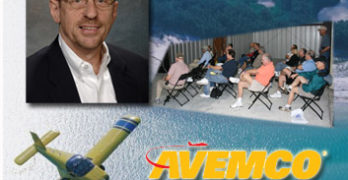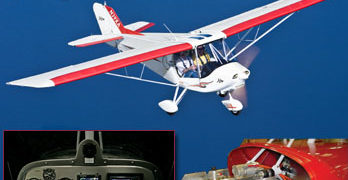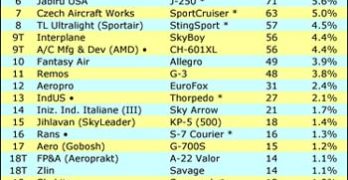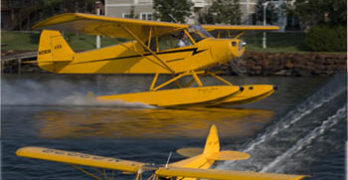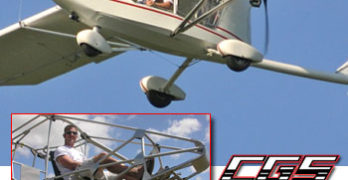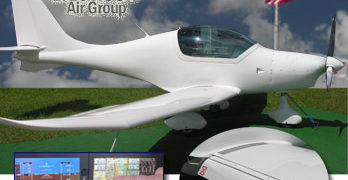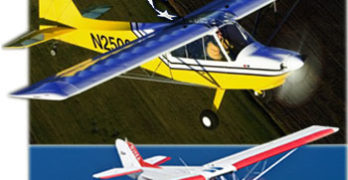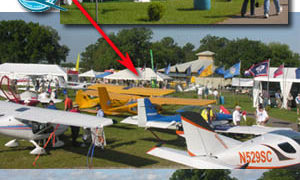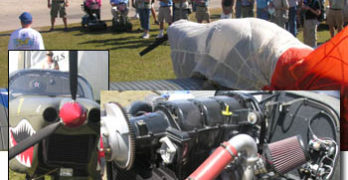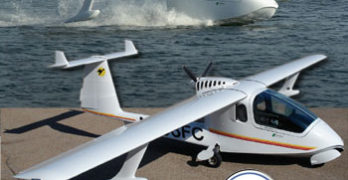Does FAA control aviation? They regulate it (sometimes well). True control may be in the hands of insurance companies. Just try to operate your airplane, your airport, your aviation business without insurance coverage. Insurance companies help keep airports open and protect our investment in airplanes when we occasionally land a bit hard. *** One company addresses market needs differently. Avemco sells directly to pilots, not through middlemen. This may explain why Avemco is one of the country’s largest airplane insurers. *** Their top man, Avemco President Jim Lauerman, has been out doing his homework on LSA. In our conversation at Sebring 2008, Jim told me about all the LSA leaders he spoke to at the event. Following Sebring he went quite a few extra miles and paid in-person visits to AMD, American Legend, and IndUS Aviation. *** Since Lauerman is personally willing to look carefully at LSA, industry players are likely to heed his advice out of respect for his interest and thoroughness.
X-Air Captures SLSA (#78); A Low-Price Leader
Many pilots have complained about the high prices of Light-Sport Aircraft. Customers expected figures like $50,000 or $60,000 (and we had choices at that price in 2003). Now, double or more is common. Read why. But not always. X-Air LS comes in at a surprisingly modest $46,900. Yes, it has sewn Dacron wings (though that helps keep it lighter; no painting). No, it isn’t as sleek as the carbon fiber jobs. Others can fly a bit faster (cruise is 90 mph). Yet for $20,000 less than we thought they should be five years ago — and about one-third the cost of many LSA today — X-Air LS will find some buyers. Indeed, X-Air had a good start at the Flying magazine Parade of Pistons, selling a LSA to the high and fast crowd. X-Air comes standard with the 85-hp Jabiru 2200, giving it spirited performance at very low fuel usage.
Aircraft Sales through April ’08 Reflect Economy
I can identify four factors in the economy presently affecting airplane sales: Potential customers (often with plenty of assets or creditworthiness) see the value of their stock portfolio going up and down like a roller coaster; worry over their once-soaring real estate, now down markedly in some areas; witness the continuing rise of the euro-dollar exchange rate, bringing much higher prices for many LSA; and, fret over a climate of political uncertainty during another election cycle. *** Perhaps due to these factors GA single engine piston sales are off 28% compared to the same period last year, according to GAMA. LSA sales are off 30% compared to trends six months to a year ago. *** Jet and turbine aircraft sales are up, but 2008 deliveries of those aircraft stem from orders taken 2-3 years ago. Contrarily, personal and sport aircraft sales react quickly to the slightest perception of economic shakiness. *** Despite that we have some bright spots.
Floatplane Season Means Fun for LSA Enthusiasts
With summer just around the corner, floatplane flying regains its special appeal. In about a month, I’ll have an announcement of a very exciting, ultramodern new seaplane that will make your jaw drop. But today, you can get an incentive at the opposite end of the LSA technology spectrum. *** Legend Cub, which offers a float option for its replica Cub, is offering $2,000 of free options with the purchase of a Legend FloatCub, base priced at $121,000. If you’ve investigated floatplane or seaplane prices you should recognize a fair value, now with a couple grand of added goodies to clinch the deal. *** FloatCub comes with Baumann 1500 Floats and experiences minimal performance reductions in this configuration. FloatCub still manages a 92 mph top speed, only 10 percent below a non-float Legend Cub. And climb remains a respectable 500 fpm. *** Unlike the other two Cub lookalikes in the LSA fleet (Sport Cub and Savage) — and unlike the original Piper Cub — Legend offers doors on both sides.
CGS Aviation’s Hawk Arrow II Wins SLSA Approval
The latest aircraft to earn Special Light-Sport Aircraft airworthiness (SLSA #77) is one of America’s most familiar and best proven models. CGS Aviation first offered its Hawk model 26 years ago, in 1982.
Since then, many model variations have been brought to market…single seat versions, two seaters, tri-gear, taildragger. Regular evolutionary changes resulted from the continuous process of development and refinement.
These efforts have sold more than 1,750 Hawks to pilots who fly them across the USA and all over the globe. *** Many years after company owner and designer Chuck Slusarczyk first offered his “real airplane” ultralight, it is appropriate that he and his Hawk Arrow II join the SLSA parade. Customers have a major reason to rejoice. Read carefully: the first 10 Hawk SLSA will be sold for $39,995 ready-to-fly with the Rotax 582.
This is, by a wide margin, the lowest price yet for any certified LSA.
Hansen Air Group Imports the German Peregrine
You probably know the Sky Arrow. This smooth tandem Light-Sport Aircraft from Italy uses exquisite construction and I found it to fly beautifully (read my report). Sky Arrow is imported by Jon Hansen and his family. Jon represented Tecnam aircraft (also of Italy) for several years, helping to launch that brand. Hansen Air Group and Tecnam ended their relationship a couple years back, and since then Jon and his team have been seeking another aircraft to represent. That search is over. *** At Sun ‘n Fun 2008, Hansen Air Group showed their new entry, the FA-04 Peregrine, built by Flaeming Air of Germany. The low wing beauty is mostly carbon fiber and was refashioned to be a Special LSA, following Flaeming’s success at winning VLA approval in Europe. Interesting Note: Hansen’s Sky Arrow also started with VLA approval, which helped it qualify as an SLSA.
Europe Takes a Major Step to Adopt ASTM Standards
If that headline didn’t cause you to turn away in boredom, let me tell you why it’s important: American producers of LSA could find a golden opportunity. Broader acceptance of ASTM standards is good for the global LSA producer community. But the main impact may be for Light-Sport Airplanes made in the U.S. of A. *** Though the example applies to any U.S.-built airplane, let’s take a ready-to-fly Rans S-7LS, selling for $85,000 in America. Today’s exchange rate is 1.58 dollars to 1.00 euro. So, a European pilot who buys an S-7LS will pay 53,800 euros (plus shipping, taxes, etc.). For EU residents, spending one euro feels much the same as it does for an American to spend one dollar. Yet when they receive 53,800 euros for an S-7LS, Rans earns a similar profit as from an $85,000 sale in the USA. *** LAMA president Tom Gunnarson — in the Czech Republic today for a show and meetings with EASA (like FAA) officials — said that under European Light Aircraft (ELA) category 1, “EASA is proposing to create a Certification Specification for Light Sport Aeroplane (CS-LSA)…having a max takeoff weight of 600 kg, the same as an American LSA.” With LAMA board member and European representative, Jo Konrad, Gunnarson is attending EASA meetings to assure LAMA members are well represented.
Big Crowds at the Sun ‘n Fun LSA Mall
Sun ‘n Fun 2008 is history, but planning is already underway for the 2009 event. Event boss John Burton confirmed we will again have the LAMA-hosted LSA Mall right at the front gate next April 21-26. A major success at this year’s Lakeland, Florida airshow, the industry Mall presentation featured 17 Special Light-Sport Aircraft. Weather prevented Fantasy Air’s Allegro from attending. Two days before the event, a tornado crushed a Sting S3 planned for display. And work at Quicksilver Manufacturing postponed the exhibit of the GT500 (they’re finishing SLSA approval, reports national sales manager, Todd Ellefson). *** The 17 who were in the ’08 LSA Mall enjoyed significant traffic all week and virtually every visitor to Sun ‘n Fun was at least exposed to Light-Sport Aircraft in a wide variety (although we were not able to enlist any trike or powered parachute companies).
IndUS Unveils the First-Ever LSA Diesel
Sun ‘n Fun has been a rip-roaring success for Light-Sport Aircraft. The new LSA Mall right at the main entrance gate has been thick with traffic all week and even the weather cooperated after a day-before-opening deluge of rain (5+ inches in a few hours!). In the days ahead, I’ll have lots more LSA news for SPLOG readers. *** On Saturday, IndUS Aviation unveiled their first-in-the-industry diesel-powered Thorpedo DP. News media and interested parties turned out to hear IndUS leaders speak about the project. The Dallas, Texas-based company finally pulled back the curtain after months of work to reveal their WAM-120 three cylinder, two-stroke engine tucked neatly under their new shapely nose cowl. *** Turbocharged and supercharged, the 120-horsepower engine burns a mere 3 gallons of Jet A per hour. This fuel is widely available around the world (important to an international seller like IndUS) where 100LL is not.
Waterbirds to Market the Colyaer Freedom Amphibian
In late 2006, the second amphibian to win SLSA approval was Colyaer’s Freedom, after CZAW’s Mermaid. Since these two, the SeaMax also joined the party, and at least two more are in development. Flying boat fans have some sweet choices. Even though we have three today, sales have been modest for a variety of reasons: manufacturing is more complex with retractable gear; marketing to a country the size and diversity of the USA is challenging; and cost of any LSA floatplane is greater than its equivalent landplane (though a fraction of the cost of a Part 23-certified airplane on floats). *** Now, welcome Waterbirds. From the people that bring you the Sting S3, availability will now be better as this new company struck a deal with LSA Aero, importer of the Freedom. Contact Larry Martin stated, “Waterbirds will manage the sales and marketing of Colyaer’s Freedom, while LSA Aero will continue to import the airplane and provide after-sales support.” *** With a wingspan greater than 40 feet, Freedom claims a glide of 20:1, an impressive figure, especially for an amphibian.
- « Previous Page
- 1
- …
- 47
- 48
- 49
- 50
- 51
- …
- 64
- Next Page »


